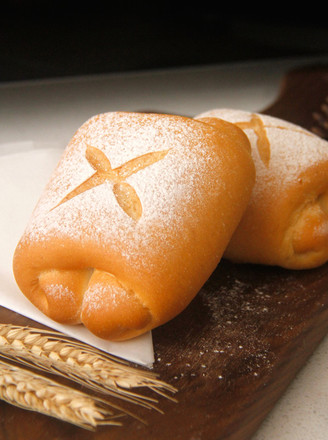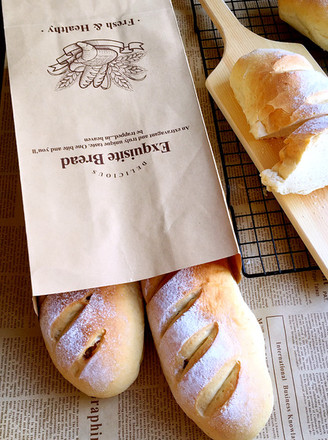[hong Kong-style Toast]: What Should I Do If The Dough is Over-sent?
1.
Mix all the ingredients of the medium type dough evenly, knead it into a smooth dough, cover it with a lid or plastic wrap, and keep it in the refrigerator for more than 17 hours. The picture shows the dough after refrigeration, the volume should be slightly increased (about doubled);
2.
After tearing the surface, you can see a uniform and dense honeycomb structure;
3.
Tear small pieces of the medium dough, mix it with the other ingredients except butter in the main dough, knead it into a smooth dough, add the diced butter;
4.
Knead until it can pull out a large piece of tough film that is not easy to break, that is, the fully expanded stage;
5.
The kneaded dough is slightly rounded and covered with plastic wrap (spread some oil on the plastic wrap to prevent sticking), let it relax at room temperature for 30 minutes;
6.
If the temperature is right, the volume of the dough after relaxation will increase a little;
7.
After the relaxation is over, ventilate, divide into 3 parts, cover with plastic wrap after rounding, and relax for 10-15 minutes;
8.
Take a small loose dough and roll it out into a long strip. After turning it over, fold the left and right sides by 1/3 to the middle respectively. After relaxing for 10-15 minutes, roll it out again into a long strip;
9.
Thin down the bottom edge of one side and roll it up;
10.
Put the rolled dough into a mold, cover it with plastic wrap, and place it in a warm and humid place for secondary fermentation;
11.
When the dough is 7-8 minutes full of the mold, lightly press the surface of the dough with your hands, leaving no traces and will bounce back. Preheat the oven 190 degrees in advance. After preheating, spray some clean water on the surface of the dough;
12.
Put the mold into the pre-heated oven, and bake it for about 40 minutes at 180 degrees. After the baking is over, immediately shake the mold out of the oven, then buckle the toast, and place it on the drying net to cool to room temperature and not burn your hands, and then it can be sealed and stored.

![[hong Kong-style Toast]: What Should I Do If The Dough is Over-sent? recipe [hong Kong-style Toast]: What Should I Do If The Dough is Over-sent? recipe](https://img.simplechinesefood.com/2e/2e9c028223a7a462cd29aa83d2954b60.jpg)
Tips:
1. When making medium dough, if you first dissolve the yeast in the liquid and then mix the flour, you only need to knead it into a dough. If you add the yeast directly to the flour and then add the liquid, it is best to knead into a smooth dough to ensure that the yeast can be evenly distributed;
2. Middle-type dough can also be fermented at room temperature. If fermented at room temperature, it should be fermented to 3 to 4 times the original volume, and the surface should be slightly sunken. If time permits, it is recommended to refrigerate and ferment to make the bread softer;
3. The dough of this bread is very wet and soft. You can put some oil on your hands and chopping board during the operation to prevent adhesion;
4. The time of the second fermentation should be adjusted according to the actual situation. As long as the height of the dough is reached and the surface is pressed lightly, it will not collapse or show any traces, and it will be fermented;
5. The specific baking time and temperature should be adjusted according to the actual situation of each oven. The bread swells to shrink slightly, spray some water on the surface of the mold, and make a "chuck" sound, which means it's baked;
6. After baking, it should be out of the oven immediately. The purpose of shaking the mold is to prevent the waist from shrinking. It is placed on the side to room temperature and then bagged. It is to use the residual temperature of the bread to make its surface softer.

![[hong Kong-style Toast]: What Should I Do If The Dough is Over-sent? [hong Kong-style Toast]: What Should I Do If The Dough is Over-sent?](https://img.simplechinesefood.com/ad/ada78f84cc10a1d16a064092e355e77d.jpg)
![[hong Kong-style Toast]: What Should I Do If The Dough is Over-sent? recipe [hong Kong-style Toast]: What Should I Do If The Dough is Over-sent? recipe](https://img.simplechinesefood.com/62/6228d9992ffd924eab75da925d79c09a.jpg)
![[hong Kong-style Toast]: What Should I Do If The Dough is Over-sent? recipe [hong Kong-style Toast]: What Should I Do If The Dough is Over-sent? recipe](https://img.simplechinesefood.com/a3/a3d3e7b8621496980f21d87c604ae20c.jpg)
![[hong Kong-style Toast]: What Should I Do If The Dough is Over-sent? recipe [hong Kong-style Toast]: What Should I Do If The Dough is Over-sent? recipe](https://img.simplechinesefood.com/09/090be3c0d6344710d8feef168952eea0.jpg)
![[hong Kong-style Toast]: What Should I Do If The Dough is Over-sent? recipe [hong Kong-style Toast]: What Should I Do If The Dough is Over-sent? recipe](https://img.simplechinesefood.com/dc/dcde186ca75ce9b3ac6af6a80d0fbb59.jpg)
![[hong Kong-style Toast]: What Should I Do If The Dough is Over-sent? recipe [hong Kong-style Toast]: What Should I Do If The Dough is Over-sent? recipe](https://img.simplechinesefood.com/4c/4ce250e803770aa2a3f97b8286c45adb.jpg)
![[hong Kong-style Toast]: What Should I Do If The Dough is Over-sent? recipe [hong Kong-style Toast]: What Should I Do If The Dough is Over-sent? recipe](https://img.simplechinesefood.com/40/40be03624ffced6d5382e1a212fcec4f.jpg)
![[hong Kong-style Toast]: What Should I Do If The Dough is Over-sent? recipe [hong Kong-style Toast]: What Should I Do If The Dough is Over-sent? recipe](https://img.simplechinesefood.com/c8/c856586d075d15c7afffe3671135ef6d.jpg)
![[hong Kong-style Toast]: What Should I Do If The Dough is Over-sent? recipe [hong Kong-style Toast]: What Should I Do If The Dough is Over-sent? recipe](https://img.simplechinesefood.com/cb/cb799a3b20a15482cdabcdd80b6c8305.jpg)
![[hong Kong-style Toast]: What Should I Do If The Dough is Over-sent? recipe [hong Kong-style Toast]: What Should I Do If The Dough is Over-sent? recipe](https://img.simplechinesefood.com/e7/e783b8a338acba1eddfaebf355d00b5f.jpg)
![[hong Kong-style Toast]: What Should I Do If The Dough is Over-sent? recipe [hong Kong-style Toast]: What Should I Do If The Dough is Over-sent? recipe](https://img.simplechinesefood.com/f4/f4400afd880de2e23542fa62fd3c79d2.jpg)
![[hong Kong-style Toast]: What Should I Do If The Dough is Over-sent? recipe [hong Kong-style Toast]: What Should I Do If The Dough is Over-sent? recipe](https://img.simplechinesefood.com/e8/e80286e88670aad9385a0fd189f6b00c.jpg)
![[hong Kong-style Toast]: What Should I Do If The Dough is Over-sent? recipe [hong Kong-style Toast]: What Should I Do If The Dough is Over-sent? recipe](https://img.simplechinesefood.com/2e/2e9c028223a7a462cd29aa83d2954b60.jpg)







